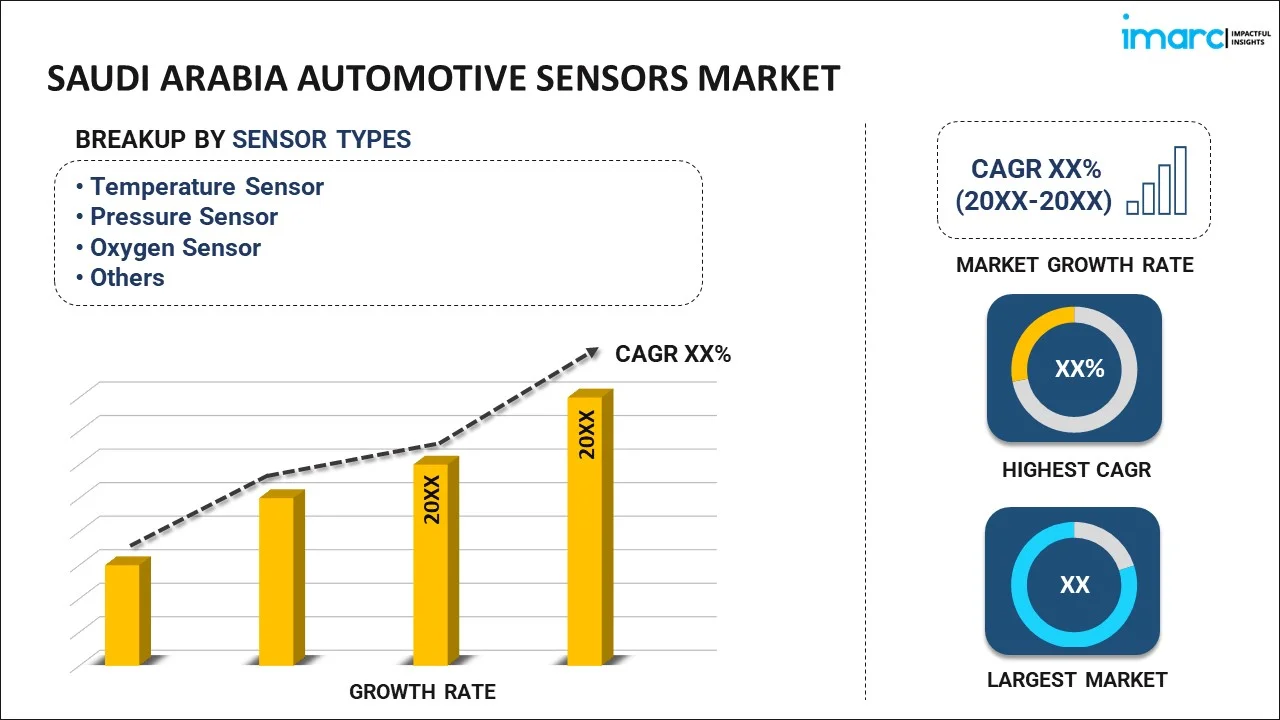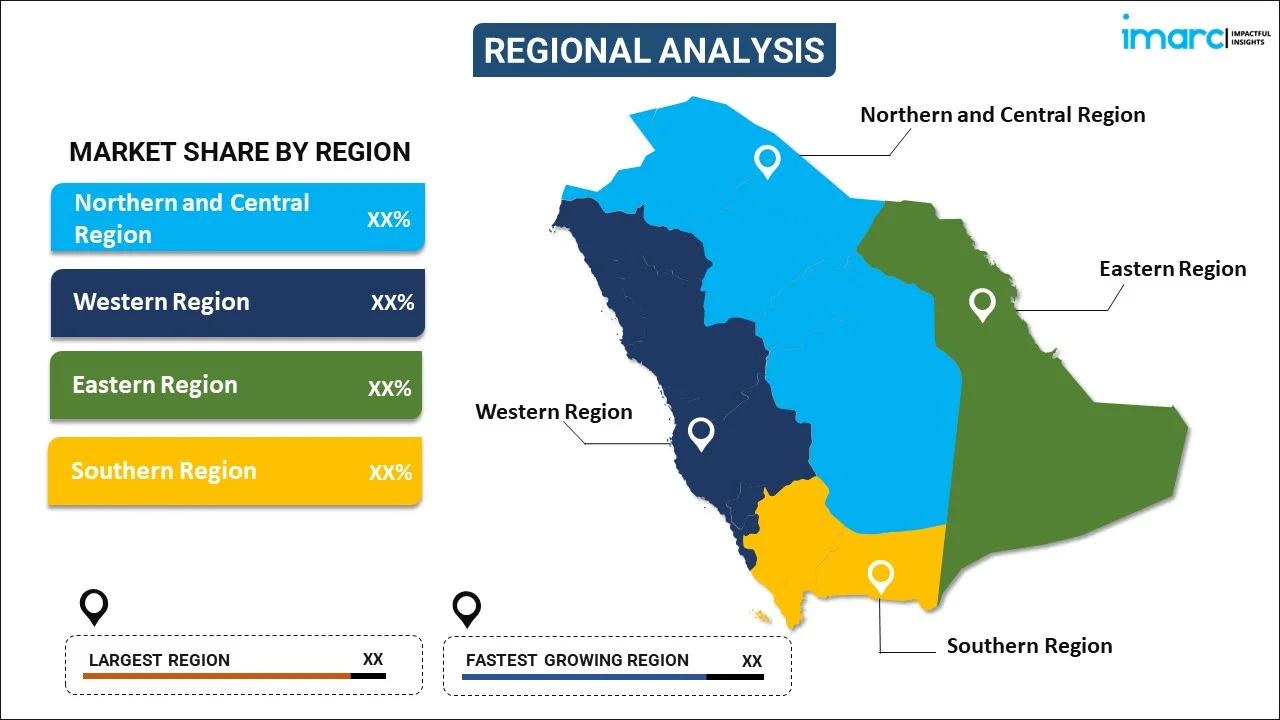
Saudi Arabia Automotive Sensors Market Report by Sensor Type (Temperature Sensor, Pressure Sensor, Oxygen Sensor, Position Sensor, Motion Sensor, Torque Sensor, Optical Sensor, and Others), Vehicle Type (Passenger Cars, Commercial Vehicles), Application (ADAS, Chassis, Power Train, and Others), Technology (MEMS, Non-MEMS), and Region 2025-2033
Market Overview:
Saudi Arabia automotive sensors market size reached USD 271.0 Million in 2024. Looking forward, IMARC Group expects the market to reach USD 446.4 Million by 2033, exhibiting a growth rate (CAGR) of 5.7% during 2025-2033. The increasing prevalence of vehicle production, along with the rising need for automotive sensors to enhance safety, improve fuel efficiency, and provide better overall performance, is primarily driving the market.
|
Report Attribute
|
Key Statistics
|
|---|---|
|
Base Year
|
2024
|
|
Forecast Years
|
2025-2033
|
|
Historical Years
|
2019-2024
|
| Market Size in 2024 | USD 271.0 Million |
| Market Forecast in 2033 | USD 446.4 Million |
| Market Growth Rate 2025-2033 | 5.7% |
Automotive sensors play a pivotal role in modern vehicles, revolutionizing the way automobiles operate and enhancing both safety and performance. These tiny yet mighty devices serve as the vehicle's sensory organs, constantly collecting data and providing crucial information to various vehicle systems. From monitoring engine performance to ensuring passenger safety, automotive sensors are indispensable components of today's vehicles. One of the most well-known automotive sensors is the engine control module (ECM) sensor, which measures parameters like temperature, pressure, and airflow to optimize engine efficiency and reduce emissions. Anti-lock brake system (ABS) sensors help prevent skidding during sudden stops by monitoring wheel speed and adjusting brake force accordingly. Similarly, airbag sensors detect impact forces and deploy airbags in milliseconds to protect occupants in the event of a collision. In addition to safety and performance, sensors also contribute to environmental sustainability. Oxygen sensors, for example, regulate the air-fuel mixture in the engine, reducing harmful emissions. Moreover, advancements in sensor technology, such as LiDAR and radar, are paving the way for autonomous driving by enabling vehicles to perceive their surroundings accurately.
Saudi Arabia Automotive Sensors Market Trends:
The automotive sensors market in Saudi Arabia is experiencing robust growth, primarily driven by several key factors. Firstly, the increasing emphasis on vehicle safety and regulatory mandates has fueled the demand for advanced sensor technologies. Additionally, the growing trend toward autonomous vehicles necessitates a higher level of sensor integration for real-time data collection and decision-making. Moreover, the rising consumer preference for connectivity features in automobiles has led to a surge in demand for sensors that facilitate vehicle-to-vehicle (V2V) and vehicle-to-infrastructure (V2I) communication. Furthermore, the ongoing development of electric and hybrid vehicles is boosting the demand for automotive sensors that monitor battery health, temperature, and power management. Apart from this, the regional shift towards environmental sustainability is pushing automakers to adopt sensors that enhance fuel efficiency and reduce emissions, aligning with stringent emissions standards. Additionally, the inflating adoption of advanced driver assistance systems (ADAS), which rely heavily on sensors for functions like adaptive cruise control, lane-keeping, and collision avoidance, is expected to drive the automotive sensors market in Saudi Arabia during the forecast period.
Saudi Arabia Automotive Sensors Market Segmentation:
IMARC Group provides an analysis of the key trends in each segment of the market, along with forecasts at the country level for 2025-2033. Our report has categorized the market based on sensor type, vehicle type, application, and technology.
Sensor Type Insights:

- Temperature Sensor
- Pressure Sensor
- Oxygen Sensor
- Position Sensor
- Motion Sensor
- Torque Sensor
- Optical Sensor
- Others
The report has provided a detailed breakup and analysis of the market based on the sensor type. This includes temperature sensor, pressure sensor, oxygen sensor, position sensor, motion sensor, torque sensor, optical sensor, and others.
Vehicle Type Insights:
- Passenger Cars
- Commercial Vehicles
A detailed breakup and analysis of the market based on the vehicle type have also been provided in the report. This includes passenger cars and commercial vehicles.
Application Insights:
- ADAS
- Chassis
- Power Train
- Others
The report has provided a detailed breakup and analysis of the market based on the application. This includes ADAS, chassis, power train, and others.
Technology Insights:
- MEMS
- Non-MEMS
A detailed breakup and analysis of the market based on the technology have also been provided in the report. This includes MEMS and non-MEMS.
Regional Insights:

- Northern and Central Region
- Western Region
- Eastern Region
- Southern Region
The report has also provided a comprehensive analysis of all the major regional markets, which include Northern and Central Region, Western Region, Eastern Region, and Southern Region.
Competitive Landscape:
The market research report has also provided a comprehensive analysis of the competitive landscape in the market. Competitive analysis such as market structure, key player positioning, top winning strategies, competitive dashboard, and company evaluation quadrant has been covered in the report. Also, detailed profiles of all major companies have been provided.
Saudi Arabia Automotive Sensors Market Report Coverage:
| Report Features | Details |
|---|---|
| Base Year of the Analysis | 2024 |
| Historical Period | 2019-2024 |
| Forecast Period | 2025-2033 |
| Units | Million USD |
| Scope of the Report | Exploration of Historical Trends and Market Outlook, Industry Catalysts and Challenges, Segment-Wise Historical and Future Market Assessment:
|
| Sensor Types Covered | Temperature Sensor, Pressure Sensor, Oxygen Sensor, Position Sensor, Motion Sensor, Torque Sensor, Optical Sensor, Others |
| Vehicle Types Covered | Passenger Cars, Commercial Vehicles |
| Applications Covered | ADAS, Chassis, Power Train, Others |
| Technologies Covered | MEMS, Non-MEMS |
| Regions Covered | Northern and Central Region, Western Region, Eastern Region, Southern Region |
| Customization Scope | 10% Free Customization |
| Post-Sale Analyst Support | 10-12 Weeks |
| Delivery Format | PDF and Excel through Email (We can also provide the editable version of the report in PPT/Word format on special request) |
Key Questions Answered in This Report:
- How has the Saudi Arabia automotive sensors market performed so far and how will it perform in the coming years?
- What has been the impact of COVID-19 on the Saudi Arabia automotive sensors market?
- What is the breakup of the Saudi Arabia automotive sensors market on the basis of sensor type?
- What is the breakup of the Saudi Arabia automotive sensors market on the basis of vehicle type?
- What is the breakup of the Saudi Arabia automotive sensors s market on the basis of application?
- What is the breakup of the Saudi Arabia automotive sensors market on the basis of technology?
- What are the various stages in the value chain of the Saudi automotive sensors market?
- What are the key driving factors and challenges in the Saudi Arabia automotive sensors?
- What is the structure of the Saudi Arabia automotive sensors market and who are the key players?
- What is the degree of competition in the Saudi Arabia automotive sensors market?
Key Benefits for Stakeholders:
- IMARC’s industry report offers a comprehensive quantitative analysis of various market segments, historical and current market trends, market forecasts, and dynamics of the Saudi Arabia automotive sensors market from 2019-2033.
- The research report provides the latest information on the market drivers, challenges, and opportunities in the Saudi Arabia automotive sensors market.
- Porter's five forces analysis assist stakeholders in assessing the impact of new entrants, competitive rivalry, supplier power, buyer power, and the threat of substitution. It helps stakeholders to analyze the level of competition within the Saudi Arabia automotive sensors industry and its attractiveness.
- Competitive landscape allows stakeholders to understand their competitive environment and provides an insight into the current positions of key players in the market.
Need more help?
- Speak to our experienced analysts for insights on the current market scenarios.
- Include additional segments and countries to customize the report as per your requirement.
- Gain an unparalleled competitive advantage in your domain by understanding how to utilize the report and positively impacting your operations and revenue.
- For further assistance, please connect with our analysts.
 Inquire Before Buying
Inquire Before Buying
 Speak to an Analyst
Speak to an Analyst
 Request Brochure
Request Brochure
 Request Customization
Request Customization




.webp)




.webp)












